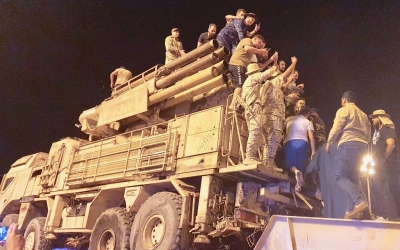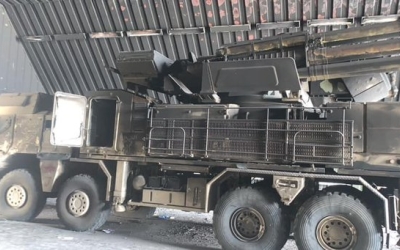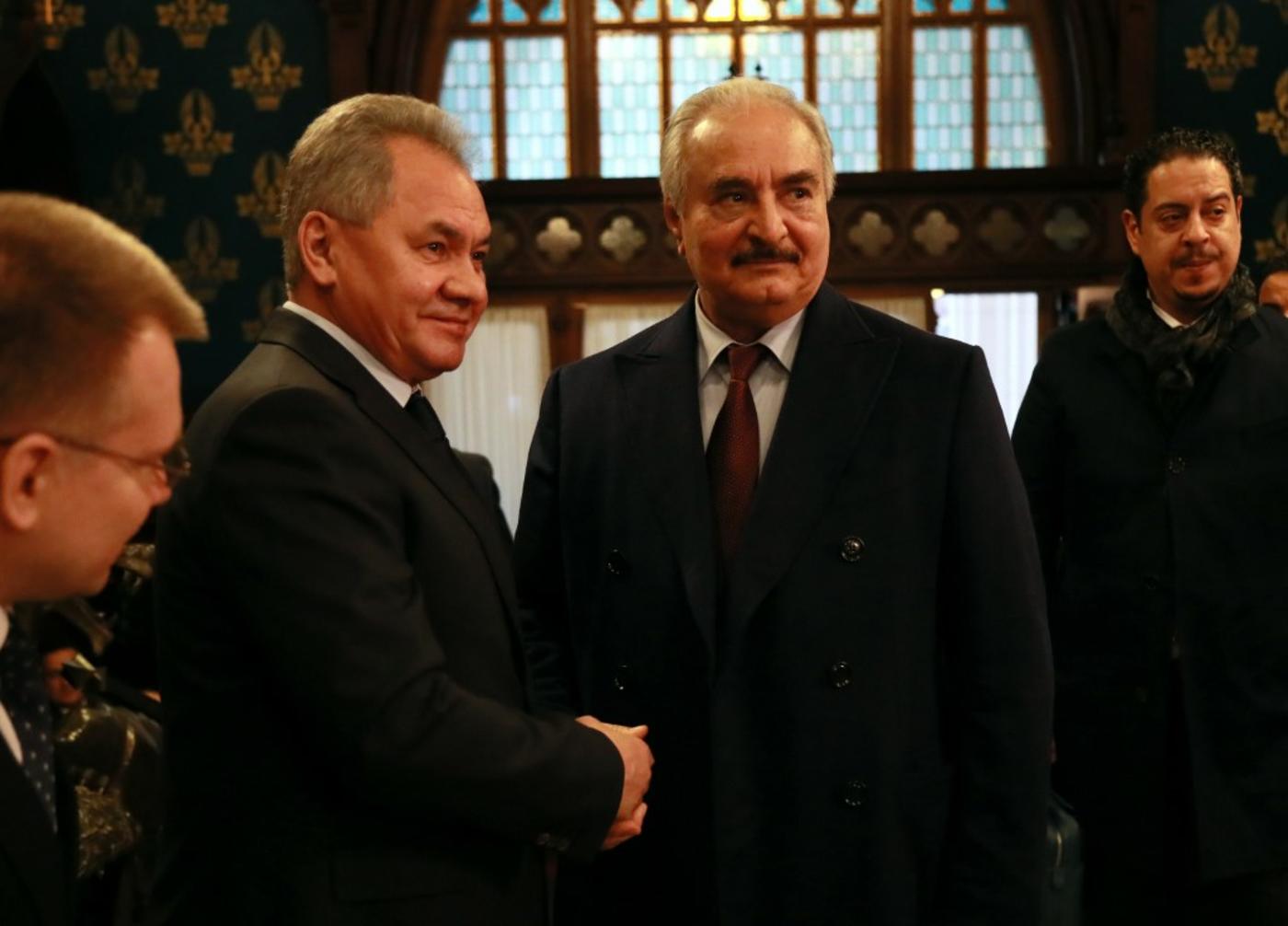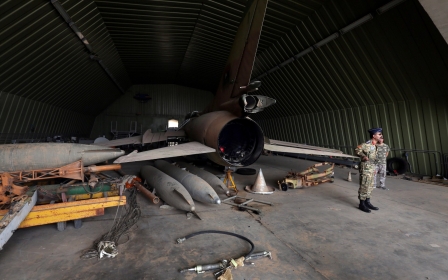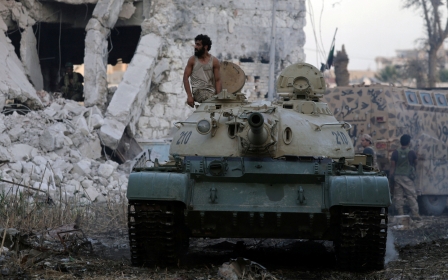Russian jets in Libya: Why Haftar's MiGs will 'change nothing' on the ground
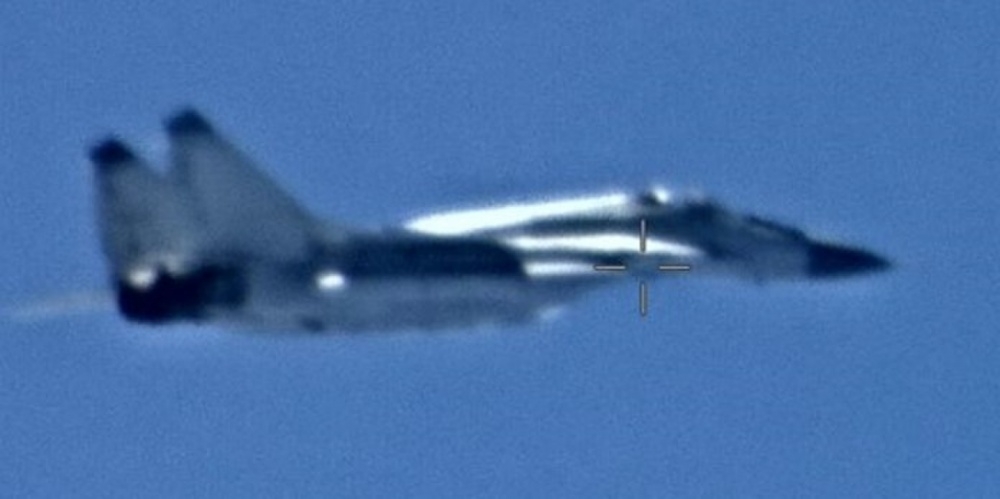
A fleet of Russian-made fighter jets which have arrived in Libya in support of Khalifa Haftar’s Libyan National Army forces are militarily “useless” and will “change nothing” on the ground, aviation analysts have told Middle East Eye.
Instead, the planes, which are probably piloted by mercenaries, have likely been deployed with Moscow’s approval in order to deter further Turkish-backed attacks on LNA forces.
At least six MiG-29 Fulcrum and two Sukhoi Su-24 Fencer fighter jets escorted by two Russian Air Force planes were reported last week to have landed in the North African country.
Fathi Bashagha, the interior minister for the internationally recognised Government of National Accord in Tripoli, told the Bloomberg news agency last Thursday that the GNA had information that the planes had arrived.
On the same day, a reliable source told MEE that a suspected “Syrian” Mig-29 was stationed at the Haftar-held airbase at al-Jufrah.
New MEE newsletter: Jerusalem Dispatch
Sign up to get the latest insights and analysis on Israel-Palestine, alongside Turkey Unpacked and other MEE newsletters
Meanwhile a satellite image taken of the base on 19 May appeared to show a MiG-29 on the facility’s taxiway, suggesting that the other seven planes were there as well.
On Tuesday, the US military’s Africa Command said it assessed that Russia had sent military fighter aircraft to Libya to support Russian state-sponsored private contractors fighting for Haftar.
The transfer-flight of this small fleet probably occurred on 14 May from Astrakhan in Russia’s northern Caucasus , via stops at Hamedan, in Iran, and at the Russian-operated Hmeimim air base in Syria, before reaching Libya several days later.
The US military said it assessed that the planes had been recamouflaged in Syria to conceal their Russian origin.
One Russian aviation website reported that the planes were modernised Syrian Air Force fighters, but Tom Cooper, a specialist in military aviation and conflict, with a deep knowledge of the Syrian Arab Air Force, told Middle East Eye that this was unlikely.
“Syria’s MiG-29s have been already overhauled and upgraded - in Syria, at Nayrab airbase. Plus, the Syrian regime has no money for a new upgrade,” he said.
According to Akram Kharief, a defence specialist, the origin of the MiG-29s could be Belarus via an order from the UAE. This type of transaction between the two countries would not be a surprise since at least three Mi-24PS helicopter gunships delivered by the UAE to Haftar in April 2015 came from Belarus.
Neither Belarus nor the UAE possesses the capability to deploy the MiG-29s to Libya without both extensive logistical assistance and political approval from the Russian state. Moreover, this discreet, even clandestine, transfer is reminiscent of the Russian Air Force's August 2015 deployment to Syria.
That comparison was also drawn by US Army General Stephen Townsend, the commander of US Africa Command, who said on Tuesday: "Russia is clearly trying to tip the scales in its favour in Libya. Just like I saw them doing in Syria, they are expanding their military footprint in Africa using government-supported mercenary groups like Wagner.
“Neither the LNA nor private military companies can arm, operate and sustain these fighters without state support - support they are getting from Russia."
Mercenary pilots
Townsend is correct that Haftar’s air force, known as the LNA/AF, does not have the pilots and ground personnel with the skills to fly and maintain this small fleet. Indeed, mastering a fighter jet like the MiG-29 requires years of training and the LNA/AF is short of good pilots.
Most of the best operational airmen of the former Gaddafi air force have been killed during the country’s years of civil war. One can therefore be almost certain that these newly introduced aircraft are not operated by Libyans.
It is also very unlikely that the pilots are Syrians, according to Cooper.
“They have next to no training - that's intentional - and require tight ground control to fly even simple ground attacks in Syria. Sending any of them to Libya now, and letting them fly there without good ground control (of which there is none in Libya), would be a complete waste of time,” he said.
The most logical inference is that these crews are former Russian and/or Belarusian pilots hired via private mercenary companies.
Attack on Tripoli
In April 2019, Haftar launched an offensive on Tripoli. As he met with tenacious resistance from local militias aligned with the GNA, Haftar's foreign backers, led by the UAE, introduced modern weaponry and thousands of mercenaries with the hope that they would help his forces enter the capital - to no avail
The destruction of about nine Emirati-owned Pantsir missile systems by Turkish drones over the last few days provides a stark illustration of this failure.
But experts do not expect the deployment of the MiG-29s or Su-24s to bring about any change in Haftar’s fortunes. Arguably, the capture of the Libyan capital by brute force alone is an impossibility.
"Bringing MiG-29s to Libya will change nothing: no variant of the MiG-29 could accomplish anything better than the Emirati Mirage 2000-9s and Wing Loongs already active in the Libyan theatre," said Cooper.
That is not to say that the new warplanes could not drop bombs on civilian areas in Tripoli. But Turkish frigates currently stationed off the coastal city have demonstrated their ability to down the UAE’s drones whenever the latter venture near the sea shore. The MiGs and Sukhois would be exposed to the same risks.
Why then send a fleet of militarily "useless" fighter bombers to Libya in support of Haftar?
As previously stated, these MiG-29s and Su-24s could not have been deployed without Moscow’s support and endorsement. Whatever the origin and ownership of these aircraft, and regardless of who is operating them on behalf of the LNA, they are indissociable from Russia - and for that reason nobody is going to risk shooting at them.
Even unarmed therefore, their presence is enough to deter Turkey from attempting an attack on al-Jufrah. By providing protection for this crucial airbase, Russia increases its sway in eastern Libya as a decisive negotiator on Haftar's side.
Turkish reaction
Turkey’s reaction to the deployment of the Russian warplanes was immediate, with several air cargo flights departing from Istanbul for Misrata, including Turkish Air Force Hercules C-130 and Airbus A400 transport planes, as well as a C-17 Globemaster III military transport aircraft likely provided by Qatar.
This air bridge suggests a reinforcement of Turkish defences, in particular anti-aircraft systems meant to build a protection bubble around Tripoli, Misrata and the Al-Watiya airbase, which GNA forces recaptured from the LNA last week.
The injection of a new batch of "low cost" Bayraktar TB2 drones is almost certain, given that over a dozen have been shot down this year.
However, Ankara is unlikely to deploy more air assets even to al-Watiya. Regardless of how often some commentators anticipate the involvement of Turkey's F-16s in the Libyan conflict, the prospect is unlikely. And so is any Turkish-Russian air combat.
Erdogan's objective in Libya has always been a rebalancing of forces in a proxy war, not a direct confrontation between state forces as has been seen in Syria.
Return to stalemate
Taking all of the above into account, and with neither Ankara nor Moscow prepared to risk an escalation, the likeliest scenario appears to be a return to stalemate and a frontline between the GNA and the LNA that existed prior to Haftar launching his offensive in April 2019. The effect of the deployment of the Russian aircraft on the side of Haftar is to enforce the status quo.
Such a scenario is consistent with a 21 May press release from the Russian Foreign Ministry following a telephone exchange between Russian Foreign Minister Sergei Lavrov and Turkish Foreign Minister Mevlut Cavusoglu which called for an immediate ceasefire, as well as the resumption of the United Nations-backed political process.
Caution is advised nonetheless. Turkish President Recep Tayyip Erdogan and Russian President Vladimir Putin had already called in January on the belligerent parties in Libya to declare a ceasefire.
The conditions of the ceasefire were accepted by the GNA, but not by Haftar who left Moscow without having signed the document proposed by Russia and Turkey.
"The worst scenario would be for these MiG-29s to start targeting hospitals and other primary installations of civilian life in the Tripoli area," said Cooper.
“Then we could expect the same exodus of millions of civilians as in Syria. During the last week the LNA has already targeted at least two hospitals in the Tripoli area with the help of BM-21 multiple-rocket launchers."
Nonetheless, the catastrophic defeats of the last few weeks suffered by the LNA and the notable loss of a major airbase may bring Haftar's foreign sponsors to the conclusion that he should be forced to negotiate or be pushed out.
This article is available in French on Middle East Eye French edition.
Middle East Eye delivers independent and unrivalled coverage and analysis of the Middle East, North Africa and beyond. To learn more about republishing this content and the associated fees, please fill out this form. More about MEE can be found here.


